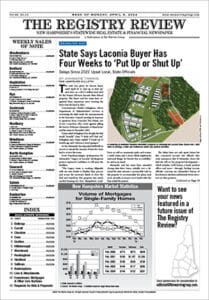
Lew Sichelman
The tea leaves are lining up in favor of homebuyers who can afford today’s higher mortgage rates.
Multiple sources indicate that more and more people are canceling their home purchases because rates have moved beyond their reach – a situation that puts “sold” houses back on the market in droves. And the phenomenon is happening in both new construction and resale.
“A lot more new-home buyers [are] canceling,” reports Rick Palacios Jr., research director at John Burns Real Estate Consulting.
And a source at the Redfin brokerage says sales of existing homes “are falling through at [the] fastest clip since 2020.”.
Consequently, if you lost out on a house in a bidding war, check back with the seller. It may be available again – possibly at a lower price.
A house is never really sold until the deal is closed and all the papers are signed. Any time before closing, buyers can walk, though they may have to pay a penalty. And if they back out, the place has to be put back on the market.
In the resale sector, some buyers are simply walking away. But others are backing out in hopes of obtaining a better deal on the same property.
“The slowdown in housing-market competition is giving homebuyers room to negotiate,” said Redfin’s Deputy Chief Economist Taylor Marr.
2022 Prices May Have Peaked
In the case of a new home under construction, builders are likely to hold the line on the asking price because they’ve already absorbed the building costs. Any discount is likely to be minimal, possibly in the form of incentives or upgrades.
There are no such restrictions if it’s a resale. Obviously, sellers can maintain their asking price if they choose. But with housing inventory creeping upward, the more likely scenario is for sellers who lose a sale to relist their places for somewhat less than before.
Take Sarasota County, Florida. According to data from the local multiple listing service, in mid-July, the median list price of contracts canceled during the previous seven-day period was $307,350. But when those houses were put back on the market, the median list price had dropped to $273,670.
According to Altos Research, housing prices have likely peaked for the year. Meanwhile, the number of houses on the market is 31 percent higher than this time last year, and they’re taking longer to sell.
“The market is changing rapidly,” said Altos founder Mike Simonsen. “When demand cools, homes get fewer offers – or no offers – and contracts start to fall through.”
Relists, Simonsen points out, “are now at their highest level [in] recent years, and they’re ticking up every week.”
Other market forces are at work when a contract is scuttled on a new house for which construction hasn’t started. Here, the builder can do just about anything they want: Raise the price, keep it the same or lower it. But with traffic down and few new buyers in sight, builders are most likely to go lower, especially since construction costs are falling.
Newly-Build Homes See Cuts
Builders always experience cancellations: People’s circumstances change, or perhaps they are unable to secure financing. But now walkaways are “extremely high,” a Phoenix builder told the Burns consulting firm in its latest survey.
Most builders don’t reveal their cancellation rates, but publicly owned companies do in their quarterly reports to stockholders. At this writing, only a few reports have been filed, but they point to better deals ahead.
The cancellation rate at KB Home was 17 percent at the end of May, compared to 10 percent for all of 2021, according to housing blogger Bill McBride. At the end of April, Hovnanian’s rate was also 17 percent, compared to 15 percent a year ago, and Lennar’s was at 11.8 percent.
At the same time, construction and labor costs are falling, which means builders can lower their prices and still maintain their margins. And they are. Here’s what some builders told the Burns firm in its most recent survey:
“Trades are more willing to negotiate pricing since [the] market has adjusted significantly [in the] past 60 days,” said an Austin, Texas, builder. A colleague from once red-hot Boise agreed: “Sales have slowed tremendously. Builders are dropping prices and halting new starts. … [We’re] expecting 15 percent to 20 percent reduction in most costs.”
It’s a similar story in Houston, where one builder reported that building product costs are down in almost every category, enabling him to use the savings for “buying down mortgage rates to get buyers qualified.” And a builder in Kennewick, Washington, confided that sales have been so slow of late that his company is “repricing our houses to try and find the new market.”
If builders haven’t started reacting to the rising number of dropouts – as well as the general falloff in sales – they almost certainly will soon.
“We’ve reached the top in pricing,” a Southern California builder told Burns. And a counterpart in St. Louis expects to see “lower costs coming in the near future, as demand cools and manufacturers and trades see backlogs shrinking.”
Lew Sichelman has been covering real estate for more than 50 years. He is a regular contributor to numerous shelter magazines and housing and housing-finance industry publications. Readers can contact him at lsichelman@aol.com.

